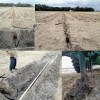 Even though drip irrigation is more efficient than the other irrigation methods, proper system management is crucial if that increased efficiency is going to result in water savings and a viable crop. One important aspect of drip irrigation management for crop success is irrigation scheduling, which includes determining both how much and when to irrigate. The grower can use several different methods to help develop a suitable irrigation schedule. Proper scheduling needs to be implemented to take full advantage of the increased drip irrigation efficiency. Two examples are presented in this 5-page fact sheet for tomatoes and peppers, which are two important vegetable crops in Florida, to demonstrate the use of reference evapotranspiration and crop coefficients in developing a drip irrigation schedule. Written by Sanjay Shukla, James M. Knowles, and Niroj K. Shrestha, and published by the UF Department of Agricultural and Biological Engineering, April 2014.
Even though drip irrigation is more efficient than the other irrigation methods, proper system management is crucial if that increased efficiency is going to result in water savings and a viable crop. One important aspect of drip irrigation management for crop success is irrigation scheduling, which includes determining both how much and when to irrigate. The grower can use several different methods to help develop a suitable irrigation schedule. Proper scheduling needs to be implemented to take full advantage of the increased drip irrigation efficiency. Two examples are presented in this 5-page fact sheet for tomatoes and peppers, which are two important vegetable crops in Florida, to demonstrate the use of reference evapotranspiration and crop coefficients in developing a drip irrigation schedule. Written by Sanjay Shukla, James M. Knowles, and Niroj K. Shrestha, and published by the UF Department of Agricultural and Biological Engineering, April 2014.
http://edis.ifas.ufl.edu/ae500
Tag: Microirrigation Systems
Subsurface Drip Irrigation (SDI) for Enhanced Water Distribution: SDI – Seepage Hybrid System (HS1217)
 In terms of water use efficiency, the traditional seepage irrigation systems commonly used in areas with high water tables are one of the most inefficient methods of irrigation, though some irrigation management practices can contribute to better soil moisture uniformity. Subsurface drip irrigation systems apply water below the soil surface by microirrigation, improving the water distribution and time required to raise the water table for seepage irrigation. This 6-page fact sheet was written by Lincoln Zotarelli, Libby Rens, Charles Barrett, Daniel J. Cantliffe, Michael D. Dukes, Mark Clark, and Steven Lands, and published by the UF Department of Horticultural Sciences, March 2013.
In terms of water use efficiency, the traditional seepage irrigation systems commonly used in areas with high water tables are one of the most inefficient methods of irrigation, though some irrigation management practices can contribute to better soil moisture uniformity. Subsurface drip irrigation systems apply water below the soil surface by microirrigation, improving the water distribution and time required to raise the water table for seepage irrigation. This 6-page fact sheet was written by Lincoln Zotarelli, Libby Rens, Charles Barrett, Daniel J. Cantliffe, Michael D. Dukes, Mark Clark, and Steven Lands, and published by the UF Department of Horticultural Sciences, March 2013.
http://edis.ifas.ufl.edu/hs1217
Agricultural Management Options for Climate Variability and Change: Microirrigation (HS1203)
 Microirrigation is the slow, frequent application of water directly to relatively small areas adjacent to individual plants through emitters placed along a water delivery line. A leading advantage of microirrigation is that evaporation that does not contribute to plant growth much less than with sprinkler irrigation. This 5-page fact sheet was written by Lincoln Zotarelli, Clyde Fraisse, and Daniel Dourte, and published by the UF Department of Horticultural Sciences, July 2012.
Microirrigation is the slow, frequent application of water directly to relatively small areas adjacent to individual plants through emitters placed along a water delivery line. A leading advantage of microirrigation is that evaporation that does not contribute to plant growth much less than with sprinkler irrigation. This 5-page fact sheet was written by Lincoln Zotarelli, Clyde Fraisse, and Daniel Dourte, and published by the UF Department of Horticultural Sciences, July 2012.
http://edis.ifas.ufl.edu/hs1203
SL-265/SS487 Dealing with Iron and Other Micro-Irrigation Plugging Problems
SL-265, an 8-page illustrated fact sheet by Tom Obreza, Ed Hanlon, and Mongi Zekri, describes problems with emitter plugging and discusses management strategies to overcome and correct causes of plugging in micro-irrigation systems. This publication focuses, in particular, on iron scaling, documenting recent successes in treating this common problem in Florida. Includes references. Published by the UF Department of Soil and Water Science, August 2008.
http://edis.ifas.ufl.edu/SS487